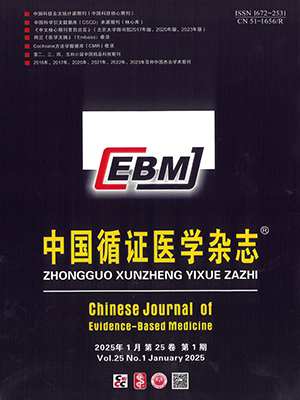| 1. |
Cameron A, Davis KB, Green G, et al. Coronary bypass surgery with internal-thoracic-artery grafts--effects on survival over a 15-year period. N Engl J Med, 1996, 334(4): 216-219.
|
| 2. |
Günaydin B, Cakici I, Soncul H, et al. Does Remote Organ Ischaemia Trigger Cardiac Preconditioning During Coronary Artery Surgery? Pharmacol Res, 2000, 41(4): 493-496.
|
| 3. |
Higgins JPT, Green S. Cochrane Handbook for Systematic Reviews of Interventions Version 5.1.0 [updated March 2011]. The Cochrane Collaboration, 2011. Available at: www.cochrane-handbook.org.
|
| 4. |
Ali N, Rizwi F, Iqbal A, et al. Induced remote ischemic pre-conditioning on ischemia-reperfusion injury in patients undergoing coronary artery bypass. J Coll Physicians Surg Pak, 2010, 20(7): 427-431.
|
| 5. |
Hausenloy DJ, Mwamure PK, Venugopal V, et al. Effect of remote ischaemic preconditioning on myocardial injury in patients undergoing coronary artery bypass graft surgery: a randomised controlled trial. Lancet, 2007, 370(9587): 575-579.
|
| 6. |
Karuppasamy P, Chaubey S, Dew T, et al. Remote intermittent ischemia before coronary artery bypass graft surgery: a strategy to reduce injury and inflammation? Basic Res Cardiol, 2011, 106(4): 511-519.
|
| 7. |
Kottenberg E, Thielmann M, Bergmann L, et al. Protection by remote ischemic preconditioning during coronary artery bypass graft surgery with isoflurane but not propofol -a clinical trial. Acta Anaesthesiol Scand, 2012, 56(1): 30-38.
|
| 8. |
Lomivorotov VV, Shmyrev VA, Nepomnyaschih VA, et al. Remote ischaemic preconditioning does not protect the heart in patients undergoing coronary artery bypass grafting. Interact Cardiovasc Thorac Surg, 2012, 15(1): 18-22.
|
| 9. |
Rahman IA, Mascaro JG, Steeds RP, et al. Remote ischemic preconditioning in human coronary artery bypass surgery: from promise to disappointment? Circulation, 2010, 122(11): S53-59.
|
| 10. |
Thielmann M, Kottenberg E, Boengler K, et al. Remote ischemic preconditioning reduces myocardial injury after coronary artery bypass surgery with crystalloid cardioplegic arrest. Basic Res Cardiol, 2010, 105(5): 657-664.
|
| 11. |
Venugopal V, Hausenloy DJ, Ludman A, et al. Remote ischaemic preconditioning reduces myocardial injury in patients undergoing cardiac surgery with cold-blood cardioplegia: a randomised controlled trial. Heart, 2009, 95(19): 1567-1571.
|
| 12. |
Kleinbongard P, Thielmann M, Jakob H, et al. Nitroglycerin does not Interfere with Protection by Remote Ischemic Preconditioning in Patients with Surgical Coronary Revascularization under Isoflurane Anesthesia. Cardiovasc Drugs Ther, 2013, 27(4): 359-361.
|
| 13. |
Thielmann M, Kottenberg E, Kleinbongard P, et al. Cardioprotective and prognostic effects of remote ischaemic preconditioning in patients undergoing coronary artery bypass surgery: a single-centre randomised, double-blind, controlled trial. Lancet, 2013, 382(9892): 597-604.
|
| 14. |
Yellon DM, Hausenloy DJ. Myocardial reperfusion injury. N Engl J Med, 2007, 357(11): 1121-1235.
|
| 15. |
Lønborg J, Engstrøm T. Determining the optimal time to introduce ischemic postconditioning. Expert Rev Cardiovasc Ther, 2011, 9(5): 541-543.
|
| 16. |
Murry CE, Jennings RB, Reimer KA. Preconditioning with ischemia: a delay of lethal cell injury in ischemic myocardium. Circulation, 1986, 74(5): 1124-1136..
|
| 17. |
Botker HE, Kharbanda R, Schmidt MR, et al. Remote ischaemic conditioning before hospital admission, as a complement to angioplasty, and effect on myocardial salvage in patients with acute myocardial infarction: a randomised trial. Lancet, 2010, 375(9716): 727-734.
|
| 18. |
Gho BC, Schoemaker RG, van den Doel MA, et al. Myocardial protection by brief ischemia in noncardiac tissue. Circulation, 1999, 94(9): 2193-2200.
|
| 19. |
Verdouw PD, Gho BC, Koning MM, et al. Cardioprotection by Ischemic and Nonischemic Myocardial Stress and Ischemia in Remote Organs Implications for the Concept of Ischemic Preconditioning. Ann N Y Acad Sci, 1996, 793(1): 27-42.
|
| 20. |
Maynard SJ, Menown IB, Adgey AA. Troponin T or Troponin I as cardiac markers in ischaemic heart disease. Heart, 2000, 83(4): 371-373.
|
| 21. |
Lehrke S, Steen H, Sievers HH, et al. Cardiac troponin T for prediction of short-and long-term morbidity and mortality after elective open heart surgery. Clin Chem, 2004, 50(9): 1560-1567.
|
| 22. |
Bignami E, Landoni G, Crescenzi G, et al. Role of cardiac biomarkers (troponin I and CK-MB) as predictors of quality of life and long-term outcome after cardiac surgery. Ann Card Anaesth, 2009, 12(1): 22-26.
|
| 23. |
Olatidoye AG, Wu AH, Feng YJ, et al. Prognostic role of troponin T versus troponin I in unstable angina pectoris for cardiac events with meta-analysis comparing published studies. Am J Cardiol, 1998, 81(12): 1405-1410.
|




